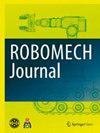小型直升机二维旋转低空速度传感器的开发和试飞验证
IF 1.7
Q3 INSTRUMENTS & INSTRUMENTATION
引用次数: 0
摘要
本文介绍了为小型直升机导航或干扰检测而设计的基于压差的二维低转速传感器的开发和飞行测试结果验证。该传感器结构紧凑、重量轻,与小型直升机的主旋翼集成在一起,由两个位于旋翼两端的探头、压差传感器、带一块磁铁和两个传感器的旋转编码器、微电脑、无线数据链和电池组成。它测量两个总压探头在每个旋翼角度捕捉到的总压之间的压差,而不是使用静压探头。因此,可以根据低速来评估机身的空速。为进行比较,使用了一个参考超声波二维空速传感器进行了飞行测试。结果表明,在使用皮托管型探头时,低速飞行($$<\sim$$ 23 m/s)的空速大小误差小于 2 m/s。风角误差近似于 30 $^\circ$$,延迟小于或等于使用全球导航卫星系统传感器观测到的延迟。本文章由计算机程序翻译,如有差异,请以英文原文为准。
Development and flight-test verification of two-dimensional rotational low-airspeed sensor for small helicopters
This paper describes the development and the verification of flight test results of a differential pressure-based, two-dimensional low-airspeed sensor designed for the navigation or disturbance detection in small helicopters. The compact and lightweight sensor is integrated with the main rotor of a small helicopter and comprises two probes at both arm ends, a differential pressure sensor, rotary encoder with one magnet and two sensors, microcomputer, a wireless data link, and battery. It measures the differential pressure between the total pressures captured by two total-pressure probes at each rotor angle, instead of using static pressure probes. Thus, the airspeed of the fuselage can be evaluated from the low speed. Flight tests were conducted employing a reference ultrasonic two-dimensional airspeed sensor for comparison. The results demonstrated that the magnitude error of the airspeed is less than 2 m/s for low-airspeed flights ( $$<\sim$$ 23 m/s) when utilizing Pitot-type probes. The error in wind angle approximated 30 $$^\circ$$ , and the delay was less than or equal to that observed with a global navigation satellite system sensor.
求助全文
通过发布文献求助,成功后即可免费获取论文全文。
去求助
来源期刊

ROBOMECH Journal
Mathematics-Control and Optimization
CiteScore
3.20
自引率
7.10%
发文量
21
审稿时长
13 weeks
期刊介绍:
ROBOMECH Journal focuses on advanced technologies and practical applications in the field of Robotics and Mechatronics. This field is driven by the steadily growing research, development and consumer demand for robots and systems. Advanced robots have been working in medical and hazardous environments, such as space and the deep sea as well as in the manufacturing environment. The scope of the journal includes but is not limited to: 1. Modeling and design 2. System integration 3. Actuators and sensors 4. Intelligent control 5. Artificial intelligence 6. Machine learning 7. Robotics 8. Manufacturing 9. Motion control 10. Vibration and noise control 11. Micro/nano devices and optoelectronics systems 12. Automotive systems 13. Applications for extreme and/or hazardous environments 14. Other applications
 求助内容:
求助内容: 应助结果提醒方式:
应助结果提醒方式:


